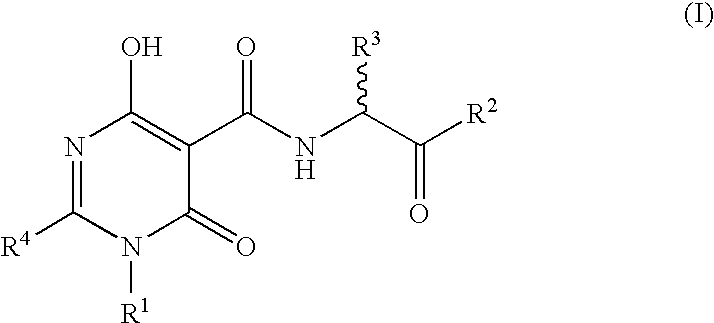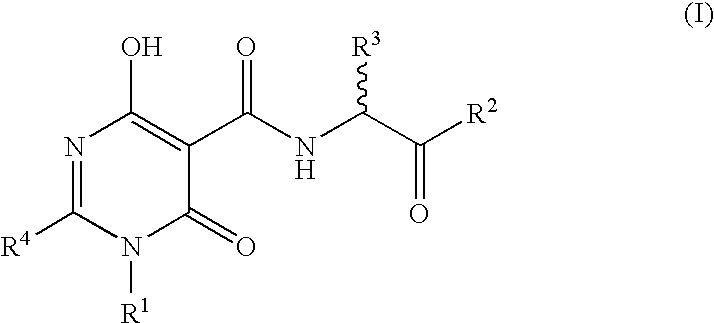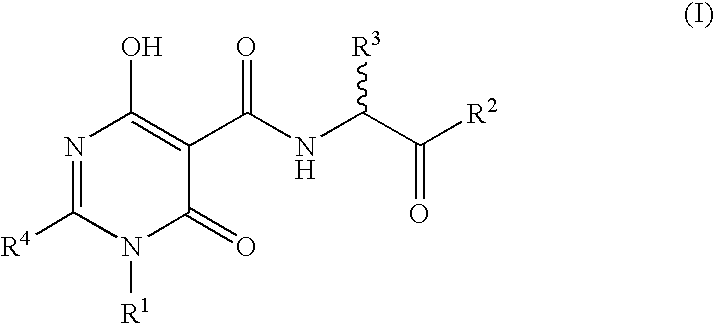N-Substituted Glycine Derivatives: Prolyl Hydroxylase Inhibitors
a technology of n-substituted glycine and inhibitors, which is applied in the direction of drug compositions, biocides, extracellular fluid disorders, etc., can solve the problems of reduced oxygen levels in the blood, ubiquitination of hif-alpha and subsequent degradation, and achieve the effect of increasing the production of erythropoietin and epo
- Summary
- Abstract
- Description
- Claims
- Application Information
AI Technical Summary
Benefits of technology
Problems solved by technology
Method used
Image
Examples
example 1
[0091]
N-{[4-Hydroxy-6-oxo-2-phenyl-1-(phenylmethyl)-1,6-dihydro-5-pyrimidinyl]carbonal}glycine
[0092]1a) N-(Phenylmethyl)benzenecarboximidamide. A mixture of copper (I) chloride (1.19 g, 12.0 mmoles), benzylamine (1.10 mL, 10.1 mmol) and benzonitrile (10 mL, 100 mmol) was stirred at 80° C. under nitrogen for 18 h, then cooled. 2M aqueous sodium hydroxide (50 mL) was added and the mixture extracted with ether. The extracts were washed with aqueous sodium hydroxide and brine, then dried (potassium carbonate, sodium sulphate). After filtering, 4M hydrogen chloride in dioxane (2.5 mL) was added and the solid filtered, washed with ether and dried to leave 1.40 g crude hydrochloride salt. 0.5 g of the salt was partitioned between 1M aqueous sodium hydroxide and ether. After washing and drying the extracts as before, the solvent was removed under reduced pressure to give the title compound (0.342 g, 45%). LCMS (ES−) m / z 211 (MH+).
[0093]1b) 6-Hydroxy-2-phenyl-3-(phenylmethyl)-4(3H)-pyrimidi...
example 2
[0096]
N-[(4-Hydroxy-6-oxo-2-phenyl-1,6-dihydro-5-pyrimidinyl)carbonyl]glycine
[0097]2a) 6-Hydroxy-2-phenyl-4(1H)-pyrimidinone. Sodium hydride (0.800 g of a 60% oil suspension, 20.0 mmol) was added portionwise with cooling to a stirred mixture of benzamidine hydrochloride (1.56 g, 10.0 mmol), diethyl malonate (1.60 g, 10.0 mmol) and 2-methoxyethanol (14 mL). After the addition, the mixture was stirred at reflux under nitrogen for 18 h, then cooled and diluted with water (80 mL) and acidified with 1M aqueous hydrochloric acid (30 mL). The precipitate was filtered, washed with water and ether, then dried to leave the title compound (1.11 g, 59%) as a pale yellow solid. 1H NMR (400 MHz, DMSO-d6) δ ppm 5.35 (s, 1 H) 7.50-7.61 (m, 3 H) 8.08-8.10 (m, 2 H), 11.80 (br s, 2 H).
[0098]2b) Ethyl N-[(4-hydroxy-6-oxo-2-phenyl-1,6-dihydro-5-pyrimidinyl)carbonyl]glycinate. A mixture of the compound from example 2(a) (0.200 g, 1.06 mmol), ethyl 2-isocyanatoacetate (0.170 mL, 1.52 mmol), N,N-diisopropy...
example 3
[0100]
N-{[4-Hydroxy-2-[4-(methyloxy)phenyl]-6-oxo-1-(phenylmethyl)-1,6-dihydro-5-pyrimidinyl]carbonyl glycine
[0101]3a) 4-(Methyloxy)-N-(phenylmethyl)benzenecarboximidamide hydrochloride. A 2 M solution of trimethylaluminium in toluene (2.50 mL, 5.00 mmol) was added dropwise to a stirred slurry of benzylamine hydrochloride (0.718 g, 5.00 mmol) in toluene (10 mL) under nitrogen. After stirring at ambient temperature for 0.5 h, 4-methoxybenzonitrile (0.665 g, 5.00 mmol) was added and the mixture refluxed for 4 h. After cooling in ice, 1 M aqueous sodium hydroxide (40 mL) was added and the mixture extracted with ether. The extracts were washed with brine, dried (K2CO3, Na2SO4) and filtered. 4 M hydrogen chloride in dioxane (2.5 mL) was added and the precipitate filtered, washed with ether and dried to give the title compound (1.25 g, 90%) as a white powder. 1H NMR (400 MHz, DMSO-d6) δ ppm 3.87 (s, 3 H) 4.69 (d, J=6.06 Hz, 2 H) 7.16 (m, 2 H) 7.33-7.52 (m, 5 H) 7.81 (m, 2 H) 9.12 (s, 1 H)...
PUM
| Property | Measurement | Unit |
|---|---|---|
| weight | aaaaa | aaaaa |
| weight | aaaaa | aaaaa |
| weight | aaaaa | aaaaa |
Abstract
Description
Claims
Application Information
 Login to View More
Login to View More - R&D
- Intellectual Property
- Life Sciences
- Materials
- Tech Scout
- Unparalleled Data Quality
- Higher Quality Content
- 60% Fewer Hallucinations
Browse by: Latest US Patents, China's latest patents, Technical Efficacy Thesaurus, Application Domain, Technology Topic, Popular Technical Reports.
© 2025 PatSnap. All rights reserved.Legal|Privacy policy|Modern Slavery Act Transparency Statement|Sitemap|About US| Contact US: help@patsnap.com



